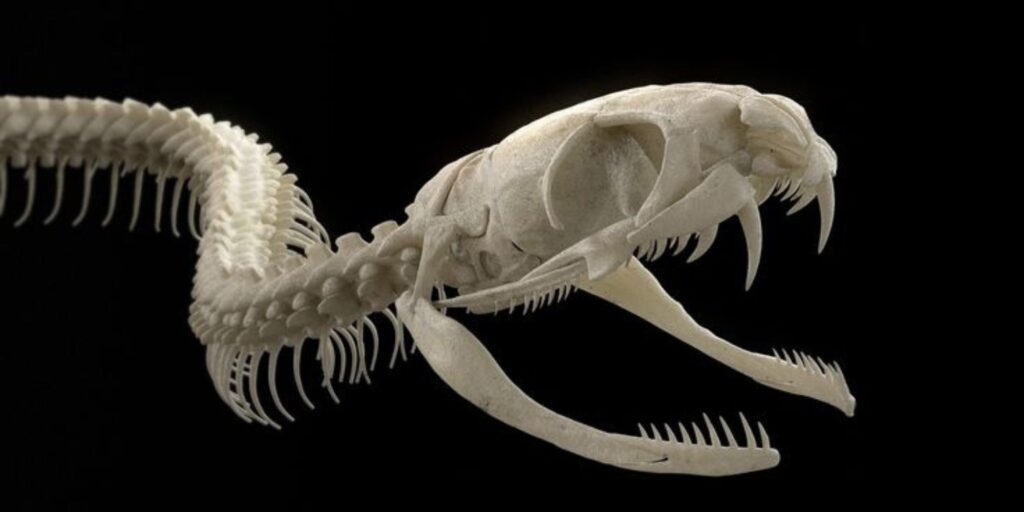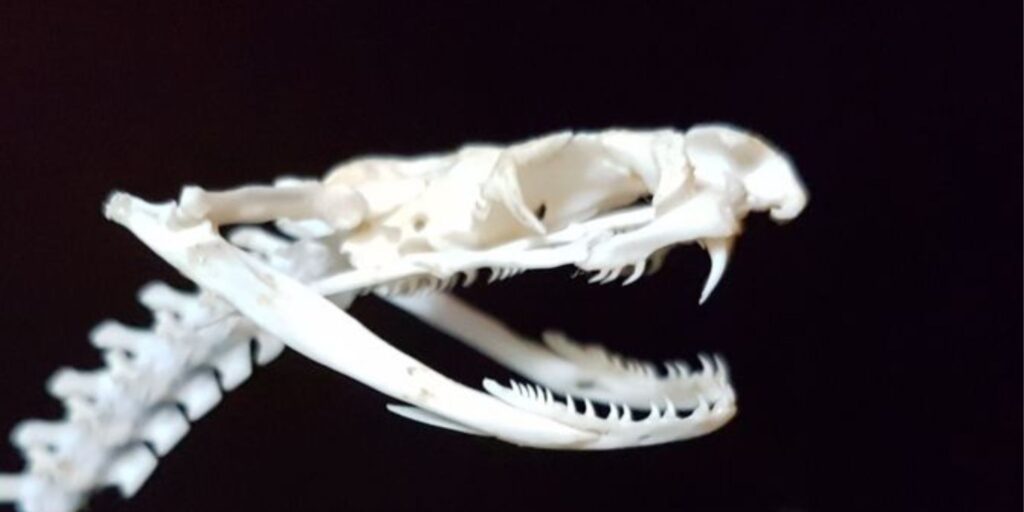Introduction
Snakes are fascinating creatures, both feared and admired. Their sleek bodies glide silently through diverse habitats, but it’s their unique skull structure that truly sets them apart from other reptiles. The evolution of the snake skull is a captivating journey through time, showcasing adaptations that have allowed these remarkable animals to thrive in various environments.
From their intricate joints to specialized teeth, snake skulls provide insight into their predatory lifestyle and survival strategies. Understanding how these structures evolved not only highlights the ingenuity of nature but also reveals the secrets behind some of the most effective hunters on our planet.
Join us as we delve deeper into this evolutionary marvel. Explore how joint flexibility enhances mobility, discover the significance of dentition in capturing prey, and unravel a taxonomic key revealing modifications across different species. The snake’s skull isn’t just an anatomical feature; it’s a storybook chronicling millions of years of adaptation and survival!
The Evolutionary Journey

The evolution of snake skulls is a remarkable tale of adaptation and survival. It all began with ancient reptiles that held the groundwork for modern snakes. As these creatures evolved, their skull structure underwent significant changes to better suit their environment and hunting strategies.
One of the most striking features of snake skulls is their highly flexible joints. Unlike mammals, which possess rigid jaw structures, snakes have multiple movable bones in their skulls. This unique arrangement allows them to open their mouths wide enough to consume prey much larger than themselves. Imagine stretching your jaw far beyond its usual limits—this flexibility is essential for a creature whose diet can include everything from small rodents to large birds.
Additionally, the cranial bones in snake skulls are loosely connected by ligaments rather than fused like those in other animals. This design grants snakes an impressive range of motion during feeding and swallowing processes. Their ability to dislocate jaws enables them not only to take on sizable meals but also aids in maneuvering around obstacles while consuming food.
How Snake Skulls Adapted Over Time
Another fascinating aspect involves how teeth have adapted over time within various species of snakes. Different types of dentition serve specialized functions based on dietary needs. For example, some snakes possess fangs that inject venom into prey, paralyzing or subduing it quickly before consumption; others feature sharp teeth designed for gripping slippery surfaces or tearing flesh apart.
As environments changed throughout history—from lush forests teeming with life to arid deserts—snake species diversified and modified their skull anatomy accordingly. These adaptations were crucial as they aimed at maximizing efficiency when hunting or evading predators within distinct habitats.
The interplay between evolutionary pressures led certain groups toward more robust head structures capable of capturing fast-moving prey effectively while allowing them also adequate defense capabilities against larger threats in nature’s grand scheme.
Furthermore, research has shown that geographic isolation played a role as well; different populations adapted uniquely
due mainly to environmental factors influencing available food sources alongside predatory challenges faced
daily—a true testament displaying nature’s unyielding capacity for innovation!
Joints of the Snake skull

The anatomy of a snake skull is nothing short of fascinating. Unlike mammals, which have bony connections between their skull bones, snakes possess highly flexible joints. This unique structure allows for an incredible range of movement.
One of the most notable features is the presence of several sutures and joints that connect the various elements of the skull. These joints enable snakes to open their mouths wider than many other animals can manage. This adaptation is crucial for feeding since it allows them to consume prey much larger than themselves.
The quadrate bone plays a significant role in this flexibility. It acts as a pivot point, allowing the jaw to drop dramatically when capturing prey. Snakes can dislocate their jaws thanks to this joint’s design, making it easier for them to engulf sizable meals whole.
Another important aspect is the kinetic nature of snake skulls. Many species exhibit considerable mobility among individual bones compared to more rigid-skull animals like lizards or birds. The freedom these bones have enables efficient swallowing mechanisms necessary for digesting large prey items without chewing.
Moreover, each type of snake has developed specific joint adaptations suited to its hunting style and diet preferences. For instance, some constrictor snakes benefit from stronger joint connections that allow them greater leverage while
wrapping around prey items before consumption.
Interestingly enough, not all snake species share identical skeletal adaptations; those who primarily hunt smaller rodents often retain tighter-fitting joints for precision strikes and quick movements during capture attempts.
In evolutionary terms, these varied modifications illustrate how adaptable and resourceful snakes are as predators within diverse ecosystems across our planet.
Snake dentition
Snake dentition is a fascinating subject that reveals much about these remarkable creatures. Unlike mammals, snakes possess a unique set of teeth adapted to their specific dietary needs and hunting strategies. The structure and arrangement of their teeth are critical for capturing, holding, and consuming prey.
Most snakes have two main types of teeth: maxillary and mandibular. Maxillary teeth are located on the upper jaw while mandibular ones reside in the lower jaw. These teeth work together in a coordinated manner to grip slippery prey effectively. Their design allows for efficient biting without allowing escape.
One striking feature of snake dentition is its diversity among species. For instance, constrictor snakes like pythons demonstrate a different dental architecture compared to venomous species such as vipers or cobras. Constrictors often have broader, more robust teeth suited for grasping while wrapping around their prey, whereas venomous snakes possess long fangs designed specifically for injecting toxins.
Snake fang length
The fang length varies significantly across families as well; some may boast elongated fangs reaching lengths up to several centimeters! This adaptation not only aids in envenomation but also plays an essential role during feeding as they can create larger wounds that facilitate swallowing by ensuring better access to vital areas within the victim’s body.
Another intriguing aspect lies with the replacement rate of snake teeth; unlike humans who have fixed sets throughout life stages, many snake species continuously replace their lost or damaged teeth over time—a process known as polyphyodonty! Some can replace each tooth every few weeks if needed—an incredible survival strategy that ensures they remain effective hunters despite inevitable wear and tear from frequent use.
Moreover, certain specialized adaptations arise when we consider diet variations between different groups like herbivorous versus carnivorous snakes or those feeding exclusively on eggs (autophagy). For example, egg-eating snakes develop an elongated tooth structure equipped with serrated edges adept at cracking open fragile shells without damaging themselves—a perfect illustration of evolution fine-tuning anatomy based on ecological niches!
Snake Skull :Taxonomic key of skull modifications
The diversity of snake skulls across various species is a testament to the incredible adaptability of these reptiles. Each modification serves a specific purpose, reflecting the ecological niches snakes occupy around the globe.
Taxonomically, we can categorize these skull modifications into key groups that highlight their evolutionary significance. First and foremost are the cranial joints, which enable snakes to consume prey much larger than themselves. Unlike mammals, snake skulls have numerous flexible connections between bones; this allows for remarkable mobility during feeding.
Next, let’s consider dentition. Snake teeth vary widely and are adapted for different feeding strategies. Some species
possess long fangs designed to inject venom into their prey, while others have shorter conical teeth suited for
grasping slippery animals like fish or amphibians.
Furthermore, some snakes exhibit specialized adaptations in their skull structure that correspond with hunting techniques and habitat preferences. For instance, burrowing snakes often have flattened heads with reduced jaw flexibility for moving through tight spaces underground.
By examining these taxonomic categories of skull modifications—joints and dentition—we uncover insights into how
varied lifestyles shape anatomical features over time. This intricate relationship emphasizes not just survival but also specialization within diverse environments.

